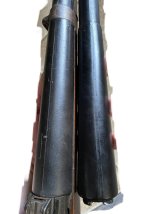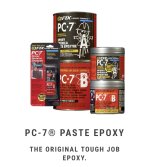
You are using an out of date browser. It may not display this or other websites correctly.
You should upgrade or use an alternative browser.
You should upgrade or use an alternative browser.
Durofol handguard missing ear repair
- Thread starter hatrick
- Start date
pitfighter
Senior Member
I have one missing one ear, so I bought a repro hand guard from Poland via Ebay, that arrived this morning.
(It's quite good, looks like it was cast from the mold made from an original hand guard - not an original mold, that is.)
I am sending mine out to be fixed - presuming the ear from the reproduction can be used.
(It's quite good, looks like it was cast from the mold made from an original hand guard - not an original mold, that is.)
I am sending mine out to be fixed - presuming the ear from the reproduction can be used.
Rogerbutthead
Well-known member
Cyrano4747
Well-known member
I haven't tried that method, but I really don't like supeglue in general for repairs of things that I care about. It's got two nasty properties: it breaks/fractures easily, and the residue is an absolute bear to clean off. It also off-gasses when it dries, and that can deposit an equally impossible to remove film on surrounding parts. I'd recommend either a two part epoxy or a urethane adhesive. They're a bit more of a pain to work with than superglue, but are also easier to remove the excess before it sets and leave nicer looking repairs. They're also less prone to re-fracturing down the road. I've used them successfully on bakelite in the past, which durofol is pretty closely related to.
edit: most epoxies are also a bit brittle when cured, but nothing as bad as superglue.
Rogerbutthead
Well-known member
Combining baking soda with the superglue doesn't make it less brittle?
Watching those DIY videos made me think the combo was super strong and had the ability to file it to the size required. I was thinking the ear isn't visible when in place, so effects on color wouldn't show - but again, I haven't tried it myself and I am not a competent handyman.
Watching those DIY videos made me think the combo was super strong and had the ability to file it to the size required. I was thinking the ear isn't visible when in place, so effects on color wouldn't show - but again, I haven't tried it myself and I am not a competent handyman.
Cyrano4747
Well-known member
Combining baking soda with the superglue doesn't make it less brittle?
Watching those DIY videos made me think the combo was super strong and had the ability to file it to the size required. I was thinking the ear isn't visible when in place, so effects on color wouldn't show - but again, I haven't tried it myself and I am not a competent handyman.
Nope. The baking soda is just a catalyst that speeds the polymerization process. It gives it a little more structure than it would have alone which is why it's good for filling in gaps, but it's just as prone to breaking as regular superglue. Frankly you don't even really need the baking soda if you don't mind waiting for it to cure the old fashioned way. As a kid I chipped the handles on a few pocket knives and filled in the void that way, just dripping in a drop of superglue every few hours and then filing it flush when it was filled up. You'll notice that in all those silly tests the video shows they're not really giving it any sharp shocks. E.g. a static weight on that screw rather than a live load. The gear wheel repair in particular is something that I'd be curious to see how it fared over an hour of use, i'm willing to bet it would chip like crazy if it's anything more than a child's lego toy.
Speeding polymerization like that also produces more fumes, and I'd be a lot more worried about that gross cloudy cyranoacrylate residue on the material being fixed. In particular with regard to handguards, I'd be concerned about it clouding and hazing the surface of the nearby durofoil. That's my biggest concern with this and a large part of why I steer clear of any super glue / cyranoacrylate type products in general for anything collectible.
Don't get me wrong, it's a nice trick if you have something that you need to fill a large void and you can't just use JB weld or bondo or a similar purpose made product for some reason. But it's not something I'd allow within fifty feet of any of my guns. Much less something that's actually valuable like a G/K.
Last edited:
Rogerbutthead
Well-known member
What product would you use to mold an ear to a G43 handguard? A link would be appreciated.
Would you expect such a repair to break within the first magazine's 10 rounds?
Would you expect such a repair to break within the first magazine's 10 rounds?
flynaked
Repo Field Gear Collector




